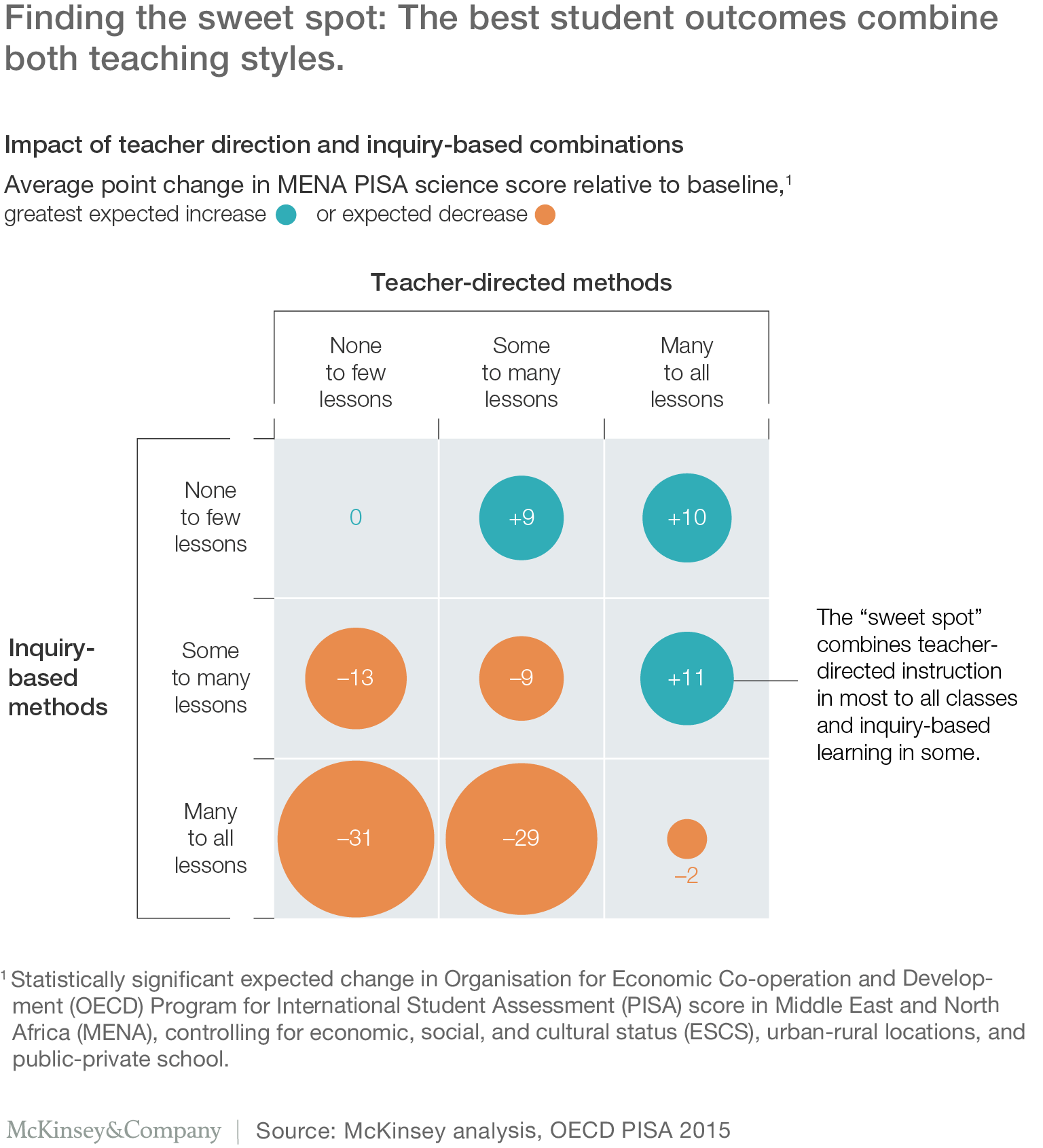Few debate the necessity of well-educated citizens. But what does it take to deliver a quality education? Our latest research offers global findings as well as deep regional analysis—the focus of this article is the Middle East and North Africa.
Stay current on your favorite topics
Previous reports on the world’s best-performing school systems (2007), and the most improved ones (2010), examined what great school systems look like, and how they can sustain significant improvements from any starting point. For this effort, we switch our focus from systems to student performance, by applying advanced analytics and machine learning to the results of the Organisation for Economic Cooperation and Development’s (OECD) Program for International Student Assessment (PISA). Beginning in 2000 and every three years since, the OECD has tested 15-year-olds around the world on math, reading, and science; it also surveys students, principals, teachers, and parents on their social, economic, and attitudinal attributes.
Using this rich data set, we have created five regional reports that consider what drives student performance. In the Middle East and North Africa (MENA), six countries participated in the 2015 PISA: two members of the Gulf Cooperation Council (the United Arab Emirates and Qatar), two countries from North Africa (Algeria and Tunisia), and two countries from the Levant (Jordan and Lebanon). On the whole, MENA’s PISA scores lag behind not only the OECD average but also behind other countries at a similar economic level.
This research is not intended as a road map to improvement; that was the theme of our 2010 report, which set out the interventions school systems need to undertake to move from poor to fair to good to great to excellent performance. Instead, this report examines five specific factors that we found to be particularly important to MENA student outcomes: mindsets, teaching practices, information technology, hours of instruction, and early childhood education.
The report’s findings include the following five highlights:
Student mindsets have triple the effect of socioeconomic background on PISA outcomes.
It is hardly news that students’ attitudes and beliefs influence their academic performance. The magnitude of this effect, and which mindsets matter most, is still under debate; and it is here that we focused our research. While there is likely a linkage between socioeconomics and student mindsets, we measured the effect of mindsets not explained by socioeconomics alone. By analyzing the PISA data, we found that mindset factors have almost double the predictive power (35 percent) compared to home environment and demographics (11 percent) on student PISA scores in the MENA countries surveyed (Exhibit 1). That is much greater than in other regions, where mindsets typically have about double the impact of home environment. Mindsets matter everywhere, then, but particularly in MENA.

Some mindsets are more important than others. For example, we compared motivation calibration (defined as being able to identify what motivation looks like in day-to-day life, including “working on tasks until everything is perfect” and “doing more than what is expected”) to self-identified motivation (defined as “wanting to be the best” and “wanting to get top grades”). In the 2015 PISA assessment, motivation calibration has almost twice the impact of self-identified ambition. Students who had good motivation calibration score 14 percent (or 55 points) higher on the science test than poorly calibrated ones. The relationship is particularly strong for students in poorly performing schools, where having a well-calibrated motivation mindset is equivalent to vaulting into a higher socioeconomic status. Students in the lowest socioeconomic quartile who are well-calibrated perform better than those in the highest socioeconomic quartile who are poorly calibrated (Exhibit 2). In contrast, students with high self-identified motivation score just eight percent higher than those without.

We also found that students with a strong growth mindset—those who believe they can succeed if they work hard—outperform by 17 percent students with a fixed mindset—those who believe that their capabilities are static. Having a growth mindset is particularly predictive for students in poorly performing schools, and for those in lower-income quartiles. Other general mindsets that are predictive of student outcomes include instrumental motivation (believing that your school science work will be useful in the future), sense of belonging at school, and low test anxiety.
To be clear, mindsets alone cannot overcome economic and social barriers, and researchers still debate the extent to which interventions can shift student mindsets at the school system level. Our findings do, however, suggest that they matter a great deal, particularly for those living in the most challenging circumstances. The research on this subject is both nascent and predominantly US-based. Considering its importance, local experimentation in MENA and elsewhere should be a priority.
Would you like to learn more about our Social Sector Practice?
The students with the best outcomes receive a blend of inquiry-based and teacher-directed instruction.
High-performing and fast-improving school systems require high-quality instruction. It’s that simple—and that difficult. We evaluated two types of science instruction to understand how different teaching styles affect student outcomes. The first is “teacher-directed instruction,” where the teacher explains and demonstrates scientific ideas, discusses questions, and leads classroom discussions. The second is “inquiry-based teaching,” where students play a more active role, creating their own questions and engaging in experiments.
Our research found that student outcomes are highest with a combination of teacher-directed instruction in most or almost all classes, with inquiry-based teaching in some classes (Exhibit 3). If all students experienced this blend, average PISA scores in the six MENA countries would rise 14 PISA points, equivalent to half a school year of learning.

Given the strong support for inquiry-based pedagogy, this seems counterintuitive. We offer two hypotheses. First, students cannot progress to inquiry-based methods without a strong foundation of knowledge, gained through teacher-directed learning. Second, inquiry-based teaching is inherently more challenging to deliver, and teachers who attempt it without sufficient training and support will struggle. Better teacher training, high-quality lesson plans, and school-based instructional leadership can help. It’s also important to note that some kinds of inquiry-based teaching are better than others. For example, explaining how a science concept can be applied to a real-world situation appears to boost outcomes whereas having students design their own experiments does the opposite.
School-based technology yields the best results when placed in the hands of teachers.
Screens are not the problem when it comes to student outcomes, but neither are they the answer. Across all MENA subregions and types of hardware, the effect of adding devices to classrooms is small, ranging from 0.2 to 1.1 PISA points per device added to a classroom (with one exception, discussed below). Across the board, we found that deploying information and communications technology (ICT) to teachers, rather than students, works best. For example, adding a teacher computer per classroom has more than six times the effect of adding a student computer. Research from other regions suggests that the use of some technologies, such as e-readers and tablets in school, actually appear to have a negative impact on student performance.
We also found that ICT has greater impact in countries where penetration is low. Adding a teacher computer in the North African countries that took PISA, for example, increases PISA scores 24.5 points. Doing the same in the two GCC countries, where classroom technology is more common, adds just 1.1 PISA points.
It is important to note that these results describe the impact of education technology as currently implemented, not its potential. Moreover, the findings evaluate only hardware, not software, and they do not consider how teachers use the technology. Even so, MENA leaders should not assume the impact of ICT will always be positive or even neutral. Systems should ensure that ICT programs are fully integrated with curriculum and instruction, and are supported by professional development and coaching.

How to improve student educational outcomes: New insights from data analytics
Improving the quality of teaching is more important than increasing the number of hours students spend in school.
Note: This section looks only at the GCC countries of the UAE and Qatar. The other MENA countries surveyed did not provide enough data for evaluation.
It makes intuitive sense that spending more time in school should improve performance, and the results bear that assumption out—up to a point. In the two GCC countries that took PISA, the average school day is approximately 5.5 hours, slightly above the global average. PISA science outcomes increase by 19.5 percent between 4 and 5 hours per day, but then only increase another 1.9 percent between 5 and 7 hours. Controlling for student socioeconomic status, type, and location of school, the highest scores are obtained by students who get 6.5 to 7 hours of instruction a day. With more than 95 percent of students in these countries already receiving 5 hours or more of instruction, there are limited gains to be made by increasing instructional hours further, especially given the added costs in terms of teacher time and infrastructure.
What matters more is improving the quality of instruction. Indeed, the UAE and Qatar did not score particularly well in the 2015 PISA in terms of PISA points per hour in school. They can make significant strides in improving student learning for every existing hour in school by minimizing non-instructional time and raising teacher quality through coaching and professional development.
Early childhood education had a positive academic impact on today’s 15-year-olds. Low-income students, however, benefited less than high-income students.
Many studies have shown that quality early childhood education (ECE) improves social and academic outcomes, although there are some concerns about fade-out in later years. Our findings confirm the overall positive impact of ECE at age 15, but indicate that there may be a trade-off between increasing access and ensuring quality.
Overall, students with some ECE perform 27 points better on the PISA science test a decade later than those with none, but there are troubling differences among students from different backgrounds. Children from lower socioeconomic status homes are less likely to have experienced ECE; among those who did, there appears to be a smaller impact on their eventual PISA scores. Starting too young appears to be detrimental: students who started ECE at age 2 or younger performed worse than those with no ECE at all. This raises concerns about the quality of ECE available, especially for younger children in lower-income families. The PISA data suggests that MENA educators would be well-served to first ensure quality universal ECE provision for four-to-five-year-olds from low-income families, and carefully monitor the quality of programs before enrolling younger children.
We are mindful of the limits of these five findings. One cannot find definitive answers from a single data source, no matter how broad or well designed. The direction of causality, sample sizes, missing variables, and nonlinear relationships are all important issues. There are still many questions that need to be resolved through a thoughtful research agenda and longitudinal experimentation. That said, we believe that these five findings provide important insights into how students succeed. MENA educators should incorporate them into their school improvement programs to deliver the progress their students deserve.


